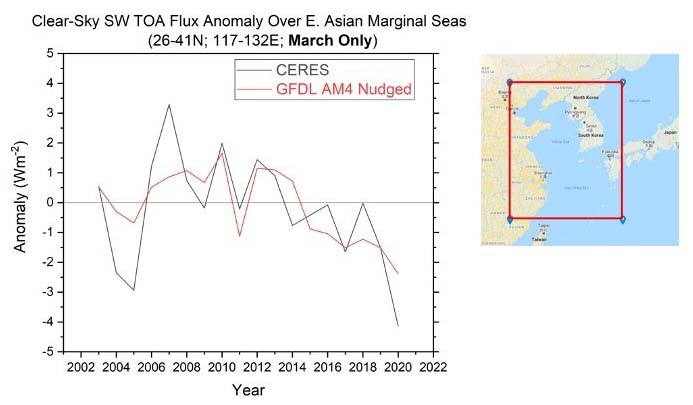Improving weather and climate modeling by studying the impact of the COVID-19-related decline in emissions of air pollutants
Restrictions on travel and social interactions implemented to limit the spread of the COVID-19 pandemic resulted in a reduced number of on-road vehicles and industrial production, leading to a significant decline in emissions of air pollutants. The resulting improvements in air quality and visibility have been widely reported in the media.
This abrupt decline in pollutants represents a unique opportunity to enhance our understanding of the complex interactions between meteorology, pollutant emissions, and atmospheric processes. In May 2020, GFDL scientists began experiments to improve the representation of atmospheric physics and chemistry in GFDL’s global weather and climate models. Two projects, described below, will look at changes in air pollution levels during the pandemic lockdowns, and improvements to simulations of fast-moving atmospheric processes in climate models.
Simulating the impact of COVID-19-related reductions in aerosol emissions using the GFDL global Atmospheric Model
The COVID-19 outbreak has led to an unprecedented reduction in anthropogenic aerosol emissions on the global scale. Little is known about how the emission reduction may affect Earth’s radiative balance, weather and climate. GFDL scientists, in partnership with scientists at NASA Langley Center, are deploying the latest global model and satellite observations to investigate these impacts. The results may hold the key to improving NOAA’s weather and climate modeling capabilities and answering one of the most prominent questions in climate science.
Scientists are using the latest GFDL global atmospheric model, AM4, driven by the re-analysis meteorological fields, to simulate the changes in top-of-the-atmosphere/surface radiative fluxes, aerosol optical depth, cloud properties and other variables, and compare them with satellite retrievals. A control simulation is created from using the standard, business-as-usual emissions, along with a perturbation simulation based on the reduced emissions. The impacts will be quantified by determining the difference between the two simulations.

This figure shows the top-of-the-atmosphere clear-sky solar radiative flux anomalies off the coast of East Asia (denoted by the red rectangle in the map) in March from 2003 to 2020 observed by NASA/CERES (black) and simulated by the nudged GFDL AM4 model using the standard emissions (red). Up to 2019, the model simulation qualitatively tracks the observed reflection reasonably. The COVID19-related emission reduction may be partly responsible for the discrepancy in 2020, a question that the ongoing simulation with the emission reduction will help address.
This work will help validate the representation of aerosols, clouds and radiation, and other fast atmospheric physical processes in global weather and climate models. These processes are collectively one of the biggest sources of biases in models. The outcome would lead to improvements in NOAA’s modeling capability and predictions, which would in turn provide useful information for planning and decision-making.


